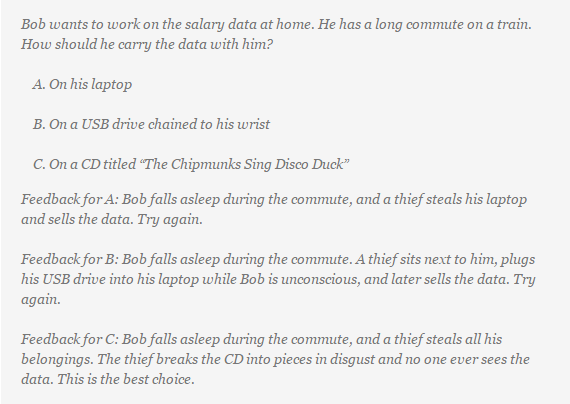Knowledge Checks Made More Effective – Scenario-based Assessments in E-learning

Assessments are, to put it simply, a method or a tool educators use to evaluate, measure the learning progress and skill acquisition of a learner. Assessments in e-learning are essential not to grade the learners but to either evaluate them or reinforce/support their learning by providing feedback. The main goal of an assessment must be to test something – either the learner’s knowledge, skill, or attitude based on what the training is on.
Let’s look at some examples.
Here’s a simple assessment question on Data Security. As you can see, it’s a basic question on the most secure way to carry data, presented with three options.

The absence of a context makes it ineffective because it doesn’t test the learner in situations he is likely to face during the course of his regular work. Now, what if you could add a mini-scenario to the above question. What would it change?

The first question asks learners to respond with no context whatsoever. Whereas, the second one combines the question with a realistic scenario/context. What a scenario does is it gives learners a snapshot of an event, providing them a brief overall description of the problem/task at hand to help them take decisions to handle the same.
But simply including a scenario won’t help the cause. What would happen if you could offer feedback for a scenario-based question (Image 2)?

(Source: cathy)
The above example includes a context and also lets learners conclude on their own from the feedback that they’ve made an incorrect choice. The results also show why that choice wasn’t the best one.
Actually ‘showing’ feedback enables the learner to think more. It embodies the way we learn in the real world – from experience. In the above example, showing the results of each decision allows learners to think a little more deeply and independently.
By paying attention to this small detail of providing valuable feedback, you’re letting people learn from a quasi-realistic experience. The more practical you make the experience, the more likely they are to remember what they’ve learned.
Where should one start?
To frame effective scenario-based questions, you must make your learners aware of the real-world consequences of their decisions. Immersing your learners in real-world scenarios will help them solve problems they might encounter in the real world. Here are some tips to keep in mind when creating scenario-based questions for your assessments.
TIP 1: The first step is to have a clear list of the instructional objectives you want to test. You can start by determining the primary purpose of the assessment. Are you trying to assess learners’ performance or giving them a chance to explore a particular area? Having a thorough understanding of their learning needs and skill sets will let you determine what approach to take while creating scenario-based questions.
TIP 2: The goal of offering scenarios is to help them solve problems they might encounter in the real world. Evaluate what kind of problems your learners face on a day-to-day basis at work. Find out if and why they are struggling at work. You can do this by interviewing the employees or involving other training managers and asking for their inputs. Focus groups are another great way of acquiring customized feedback from the key members of your learning audience.
NIIT’s Critical Mistake Analysis is one such methodology to identify the common mistakes made by employees. It basically allows you to create a Pareto Chart to derive an 80/20 distribution of the overall business impact due to the mistakes to determine how much emphasis each mistake should receive in training. (Source)
TIP 3: Scenarios require a lot of help from the Subject Matter Experts (SMEs). With some help from an SME, you can make sure everything is accurate and realistic. Also, they can assist you in phrasing difficult questions and creating subtle questions that are real and close to the problems learners face at work.
First, you’ll want the SME to validate your list of learning objectives-and your prioritization of those objectives. Second, you’ll want your SME to approve the list of key situations your learners will face on the job. Finally, you’ll want to get your SME to validate your scenario-based questions.
TIP 4: When it comes to assessments, productive failure is probably the most effective way to achieving effectiveness (Clark, 2012). Problem-based learning is also better for long-term retention and skill development. The biggest benefit of scenario-based questions is that it allows learners to learn from their mistakes in a safe, risk-free environment.
Plunge your learners into a realistic scenario – followed by another and yet another. By doing so, you are giving them a safe place to try, fail, and learn.
These tips will help you create realistic and effective scenario-based questions for your e-learning that both immerse and inform your learners, allowing them to understand real-world consequences of their choices.





